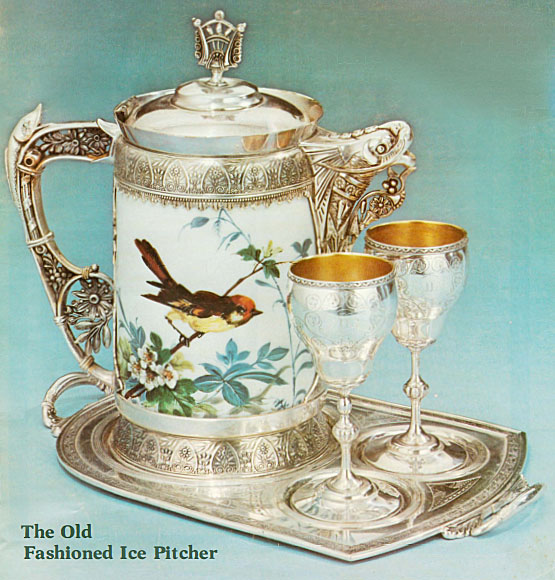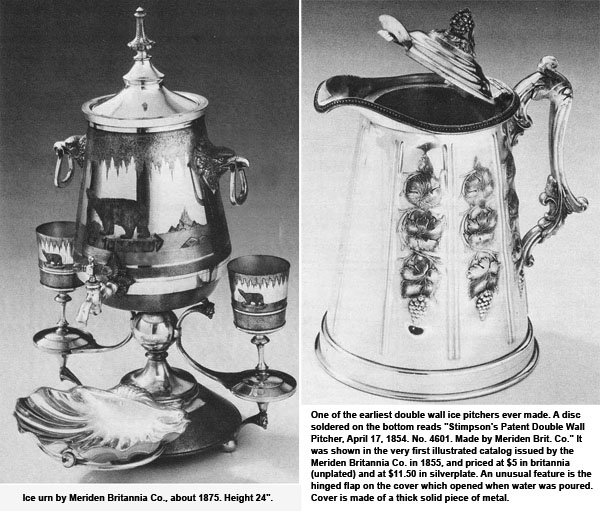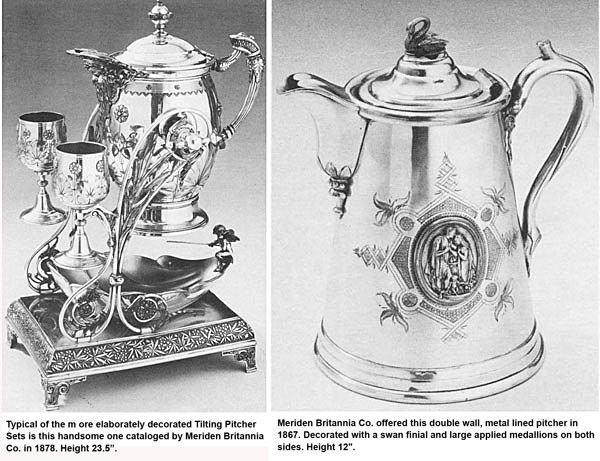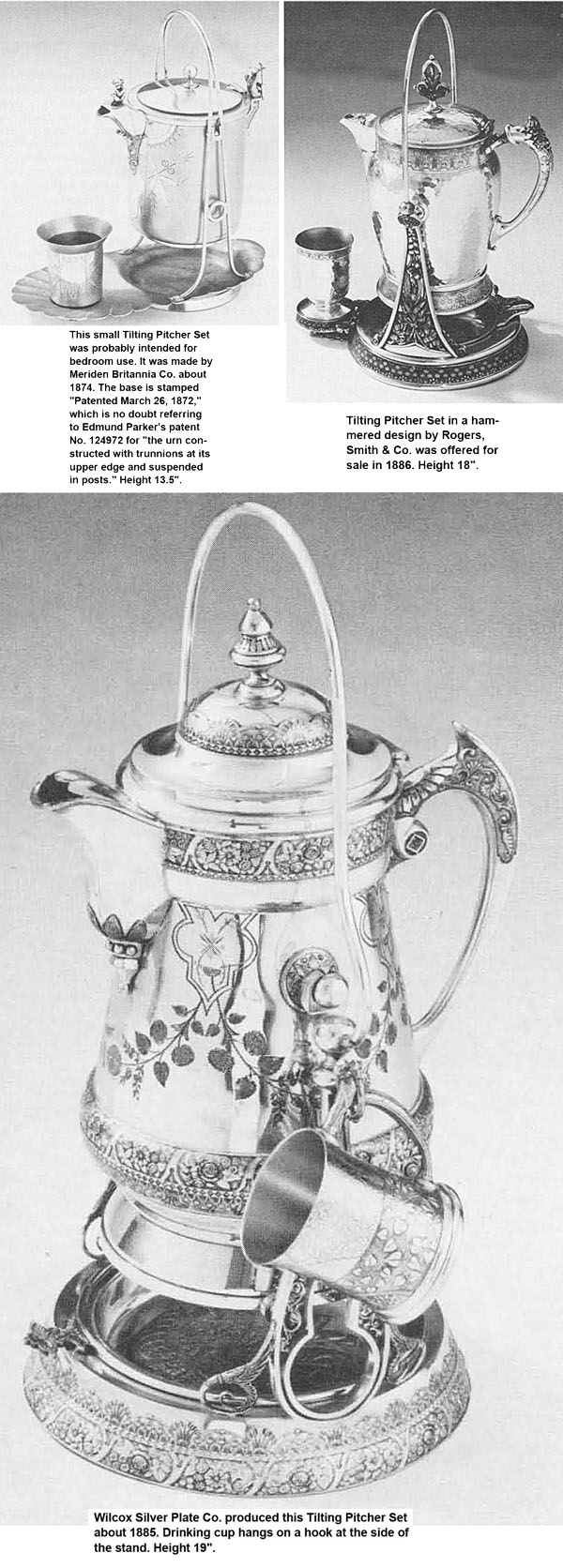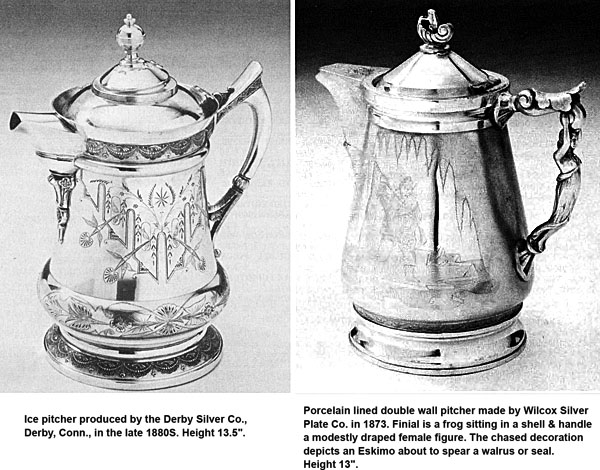quote:
DID OUR ancestors drink more water than we do today? Probably not, although the amount of space devoted to and the emphasis placed on ice pitchers in old silverware catalogs might lead one to this conclusion.In the days before mechanical refrigeration the problem seems to have been not so much a lack of ice, but some means of restraining it from rapidly melting in the water pitcher.
From Eric Sloane's fine book, American Yesterday, we learn that the ice business was a major industry in early America. The first ice houses were farm root cellars and by 1830 ice houses were standard equipment on farms. Commercial ice cutting increased and by 1907 there were some 10,000 men cutting ice during the winter months, and some ice storage houses were so huge that clouds formed and rain fell within them.
Even in the small town of Meriden, Connecticut, around 1895, population then 25,423, the largest of several ice dealers serving the area employed 65 men during the harvesting season, and during the summer months used 35 men and 40 horses for delivering ice to homes.
Some indication of the size of the American natural ice business may be gained from Boston figures which, as early as 1847, show 51,887 tons shipped to coastal ports and 22,591 tons sent abroad. In terms of dollars this was far above the half million dollar mark, and multiplied by the hundreds of other ice businesses it can be seen that it was a major industry.
The invention of James Stimpson of Baltimore of a double wall ice pitcher filled a need and was hailed as a great improvement toward keeping water cool and retarding the rapid melting of the ice.
Patent No. 11819, granted October 17, 1854 (antedated April 17, 1854), was actually issued to James H. Stimpson, his son and executor. Its chief feature was a metal pitcher with an inner body, also of metal, but separated from the exterior by an air space which acted as an insulator against the outside temperature. The patent was extended for seven years and reissued June 9, 1868. It was used on a royalty basis by a number of silver makers. Some of the ice pitchers turning up in antique shops today have this marking on a metal disc soldered on the bottom.Then on March 8, 1859, an even greater improvement was patented (No. 23.2000) by James H. Stimpson wherein the inner body was porcelain-coated instead of plain metal. This patent was bought from Simpson's widow in 1868 by H. C. Wilcox, acting for the Meriden Britannia Company. The original patent papers and copy of the bill of sale are preserved in International Silver Company's Historical Library.
The Meriden Britannia Co. catalogs of 1871 and 1878 feature these statements:"The silverplated porcelain lined Ice Pitchers are not only the cheapest and best for service, but are the only pitchers now made that meet the popular demand, there being over forty thousand (40,000) now in use."
State Assayer's Office
20 State St., Boston,
June 5, 1868
Meriden Britannia Company
West Meriden, Conn.Gentlemen:
I have made a careful examination of the PORCELAIN LINED ICE PITCHERS recently manufactured by you. The lining or inner chamber of these Pitchers is made of WROUGHT IRON, worked into the desired form, and then enameled inside, where it comes in contact with the ice and water. This enamel is a species of Porcelain that has been melted upon and attached to the iron at a high heat; it forms a smooth, glazed surface, like other kinds of Porcelain , AND IS ENTIRELY FREE FROM ANYTHING POISONOUS OR INJURIOUS.
These linings have been submitted to a variety of severe tests here, with a view to determine their durability and power of resisting the corrosive action of natural waters. A quart of acidulated well-water was boiled in one of them without any perceptible action upon the enamel; and, again, a well-water, to which caustic alkali had been added, was afterwards boiled in the same lining, with a similar result. When submitted to sudden changes of temperature, the enamel did not crack or separate from the iron; and sharp strokes with pieces of ice failed to make any impression upon it. If the water in a Pitcher should at any time come in contact with the iron, it would not then be injurious to health.
There are many apparent advantages in these linings besides those already mentioned-such as FREEDOM FROM ODOR, AND CLEANLINESS-BUT THE ABSENCE OF ANY INJURIOUS MATERIAL, in the construction of this inner chamber, SHOULD BE THE FIRST CONSIDERATION IN SELECTING A SAFE ICE PITCHER FOR DAILY USE.
S. Dana Hayes
State Assayer of Massachusetts
There was a rash of "improvements" in water cooling pitchers for which patents were granted. James H. Stimpson was granted No. 21717, October 5, 1858, for a treble wall pitcher. He acknowledged that this was heavier and more expensive to make but stated that "for very hot climates and damp atmosphere it is of special use.""Lyman's Patent Double Valve" (SW apr '74) issued June 8, 1858, was placed in the throat of the pitcher and kept out the warm air and was used in all those made by the Meriden Britannia Company.
Among other patents which were bought by Meriden Britannia Co. was one by Alonzo Hebbard of New York (No, 18546 -- Nov. 3, 1857) for "the use of the combination of the woolen cloth or felt covering as an elastic non-conducting packing" (around the inner shell). One in 1857, No. 190,895 to Edmund A. and his brother, John E. Parker, of West Meriden, Conn. covered construction features whereby the base, outer shell, and inner vessel were made separately and joined by bolts between the two walls.
Henry B. Beach (a silverplater at Wilcox Silver Plate Co.) was granted patent No. 8444 (reissue) April 30, 1878, for various construction details which included a metallic covering to be tightly spun over the porcelain or crockery lining to make a stronger lining and "prevent sweating." Another patent in his name, No, 209446, dated October 5, 1878, included, among other things, a lip or spout so constructed as to prevent water collecting in the spout, getting warm and being shed when the pitcher was next used. Such a condition, he stated, was "often to the great annoyance of the person pouring water."There was also one for March 27, 1872, No. 124972 to Edmund A. Parker for "the urn constructed with trunnions at its upper edge and suspended in posts, when constructed with the spout and a device thereon for tilting the urn."
The ice pitchers were heavy, some weighing 10 pounds empty, and it was not long before there were a number of 1885. Drinking cup hangs on a hook at the side of the stand. inventions patented for stands on which the pitcher could be Height 19". tilted for pouring. These usually included platforms for one or two goblets and were called "Tilting Pitcher Sets." Some had a cup hanging on a hook on the stand.
Simpson, Hall, Miller &Co. of Wallingford, Conn., in 1868, and again in 1872, featured a "patented corrugated strengthened bottom, applied to all our pitchers." Wilcox Silver Plate Co. in 1886 featured a "removable porcelain lining," and there were others too numerous to mention.
Although there were double, triple, and even quadruple walled pitchers, it was the double wall style which survived the longest. However, the Rogers Bros. Mfg. Co. and Rogers, Smith & Co. with which they had an association (SW nov '73) decided to put their money behind the triple wall style. Both firms, in 1860, published in their catalogs a chart showing the results of a test of various types.
In this test the ice in the triple wall pitcher lasted 10 hours before it finally melted and the water temperature stood at 45 degrees. I n the double wall, ice was gone in six hours and at 10 hours the water had climbed to 57 degrees. In a plain "stone china pitcher" the ice only lasted three hours and at the end of the period the water was 72 degrees -one degree warmer than at the start. During the 10 hour period of the test the atmosphere went from 75 degrees to a high of 78 degrees. Thus was proved the superiority of the triple-wall pitcher.
Some idea of the popularity of the old fashioned ice pitcher may be drawn from the amount of space devoted to them and the variety of designs offered in the old catalogs.
Wilcox Silver Plate Co. in 1868 showed only seven styles offered with a variety of chased ornamentation. By 1886, they showed 12 designs, plus 10 tilting pitcher sets. Middletown Plate Co. showed 20, plus eight Tilters in 1879, and in the same year Meriden Silver Plate Co. offered 16 pitchers, eight Tilters and a large ice water urn. Derby Silver Co. had 18 pitchers and nine Tilters in 1883.
Meriden Britannia Co., the largest silverware company, started with 14 styles in 1861-62. By 1867 this had increased to 36; for 1879, 45; for 1882, 46; and in 1886, 35 pitchers, 22 tilting pitcher sets and seven urns ranging from three to ten gallons. However, by 1896, this had dwindled to 14 patterns and by 1900, the domestic demand had practically disappeared.
All these firms became part of International Silver Company when it was formed in 1898.
Another large maker of silverplated holloware was Reed & Barton of Taunton, Mass., and in a large, handsome catalog issued in 1885 they showed 51 different styles of ice water pitchers.
The popularity of the double wall pitcher led to other forms, some with outside shells of paper-mache or thick, solid porcelain fitting tightly over the metal body. These were hand painted with colorful decorations in a variety of ways.
Although the domestic demand faded away around the turn of the century, ice pitchers still continued popular in foreign countries. In a 233-page catalog produced especially for the export trade by International Silver Co. around 1905 or 1906, 29 ice pitchers are shown, plus 16 tilting pitcher sets.
And where did the warm climate countries get their ice? Why from the ingenious Yankees of course, who had long found it a profitable business. One of the earliest ice merchants was Frederic Tudor of Boston who, in 1805 at the age of 21, borrowed $10,000 and bought the brig, Favorite. During December 1805 and January 1806, he employed men to cut ice and deliver it to his ship, and near the end of February 1806, he set sail for Martinique. His first voyage was not a success; he claimed to have lost $3,000, largely because the need for and uses of ice had not been fully developed.
Tudor was delayed in his efforts by embargoes on foreign trade, and the War of 1812, but he was a persistent man and when embargoes were lifted and the war ended, he sailed to Havana and built the first successful above-ground ice house.
In 1816 he sold 1200 tons of ice; by 1856, sales had increased to 146,000 tons a year. He shipped ice to Bombay, Calcutta, Havana, and even China, as well as to southern United States. On his 65th birthday in 1849, he admitted to friends to being a rich man. He died during the Civil War, in 1864, at the age of 80.
Other enterprising Yankees followed Tudor's lead and no doubt some of this Yankee ice ended up in the "old fashioned" ice pitchers produced in such great numbers by the Yankee silver makers.










